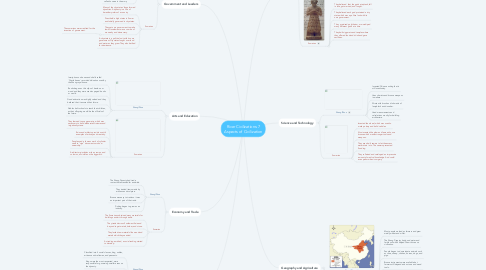
1. Government and Leaders
1.1. Shang/Zhou
1.1.1. Shang kings were surrounded by a court who performed rituals to strengthen the kingdom.
1.1.2. The king appointed governors to rule parts of the kingdom.
1.1.3. The king had a large army responsible for preventing rebellions.
1.1.4. Most people spent their time in the fields tending to crops. From time to time farmers would be called to serve in the army.
1.2. Sumerian
1.2.1. Many of the city-states' kings formed dynasties. A dynasty is a line of hereditary rulers of a country.
1.2.2. Priest held a high status in Sumer and initially governed in city-states.
1.2.3. They set up a government to make laws.Government was a combo of monarchy and democracy.
1.2.3.1. The sumerians were credited for the invention of government.
1.2.4. A city-state is a political unit with its own government.City states fought over land and water as they grew. They also battled for dominance.
2. Arts and Education
2.1. Shang/Zhou
2.1.1. Inscriptions on bones and shells called 'Oracle bones' recorded divination used by the Shang royal house.
2.1.2. Books began as thin slips of bamboo or wood and they were used as paged books or scrolls.
2.1.3. Good education was highly valued and they believed that it ensured their future.
2.1.4. Nobles built schools to teach their children, as their offspring would be the officials of the future.
2.2. Sumerian
2.2.1. They learned to use geometry, which was necessary to build elaborate structures and irrigation systems.
2.2.2. Ruins and artifacts provide us with examples of artistry and creativity.
2.2.3. People used a famous work of cylinder seals to"sign" documents or show ownership.
2.2.4. Architecture includes arches, ramps, and columns, all visible on the ziggurats.
3. Economy and Trade
3.1. Shang/Zhou
3.1.1. The Shang Dynasty had trade routes that extended far and wide.
3.1.2. They traded items made by artisans and sculptors.
3.1.3. Bronze was easy to trade so it was an important part of the trade.
3.1.4. Fishing began to grow as an industry.
3.2. Sumerian
3.2.1. The Sumerians obtained many materials for buildings and art through trade.
3.2.2. They traded across Southwest Asia and beyond to get metals,timber, and stone.
3.2.3. They lacked raw materials like wood and metals which they needed.
3.2.4. As trading enriched, a social ranking started to develop.
4. Social Structure and Family Life
4.1. Shang/Zhou
4.1.1. Classified into 4 social classes, king, nobles, artisans and craftsmen, and peasants.
4.1.2. Kings were the most respected, were responsible for governing smaller areas on the dynasty.
4.1.3. Nobles worked in the infantry and were chariot warriors.
4.1.4. Artisans and craftsmen were middle class and mainly worked with bronze. Peasants were mostly farmers.
4.2. Sumerian
4.2.1. Kings, priests and principals were the highest in the social structure.
4.2.2. Slaves were at the very bottom in the social structure. They were captured during battle.
4.2.3. Men held political power and made laws but they weren't necessarily higer than women.
4.2.4. Women took care of home and children. Some received education and served in temples.
5. Religion
5.1. Shang/Zhou
5.1.1. The Shang Dynasty was Polytheistic, meaning they worshiped many gods.
5.1.2. Ancestor warship was very important to the Shang Dynasty
5.1.3. It was the thought that the success of crops and health of people was based on the happiness of dead ancestors.
5.1.4. Animals were usually sacrificed to please gods or ancestors, human sacrifices were also practiced on occasion.
5.2. Sumerian
5.2.1. They believed that the gods ate,drank,fell in love,got married, and fought.
5.2.2. They believed each god protected a city state which was a political unit with its own government.
5.2.3. They practiced polytheism, or worshiped many different gods at a time.
5.2.4. They built ziggurats and temples where they offered food and drink and gave sacrifices.
6. Science and Technology
6.1. Shang/Zhou
6.1.1. Invented Chinese writing that is still used today.
6.1.2. Uses chariots and bronze weapons in warfare.
6.1.3. Wrote with brush and ink made of lampblack and cinnabar.
6.1.4. Used measurements and calculations mostly for building architecture.
6.2. Sumerian
6.2.1. Invented the wheel, which was used to make pottery and build vehicles.
6.2.2. Also invented the plow and learned to use bronze which made stronger tools and weapons.
6.2.3. They even built sewers to let the excess water drain in to. The sewers prevented flooding.
6.2.4. They collected and cataloged an impressive amount of medical knowledge. And could even perform basic surgery.
7. Geography and Agriculture
7.1. Shang/Zhou
7.1.1. Most people worked as farmers and grew mainly wheat and millet.
7.1.2. The Shang Dynasty had good water and fertile soil which helped them thrive as a civilization.
7.1.3. People began to domesticate animals such as cows, sheep, chicken, horses, dogs, and pigs.
7.1.4. Bronze instruments were available but farmers still depended on stone and wood tools.
7.2. Sumerian
7.2.1. Nicknamed "land between the rivers" and the rivers are Tigris and Euphrates Rivers.
7.2.2. People farmed because the land was well suited for agriculture like growing crops.
7.2.3. The Sumerians developed canals to carry the water and to control flooding.
7.2.4. Their region was fertile and they had very rich soil for their crops.

